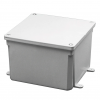I installed a second cam this weekend using this adaptor. I can see both PoE cams in BI and has been working fine so far. We will see how long it lasts as it is outdoors. I am thinking of getting a second one instead of those "protected/outdoor" versions that cost like 3x.
I ended up buying 3 more from Ebay. Now I need to buy more good cameras... Linovision PoE Extender Passive 2 Port 802.3af/at, FREE SHIPPING | eBay
As an eBay Associate IPCamTalk earns from qualifying purchases.






